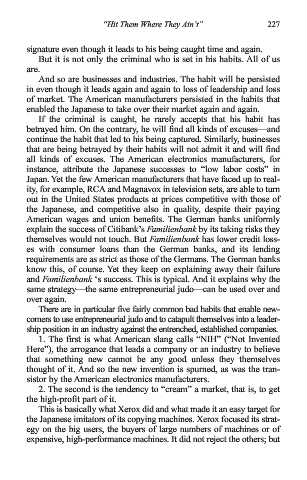Page 234 - ENTREPRENEURSHIP Innovation and entrepreneurship
P. 234
53231_Innovation and Entrepreneurship.qxd 11/8/2002 10:50 AM Page 227
“Hit Them Where They Ain’t” 227
signature even though it leads to his being caught time and again.
But it is not only the criminal who is set in his habits. All of us
are.
And so are businesses and industries. The habit will be persisted
in even though it leads again and again to loss of leadership and loss
of market. The American manufacturers persisted in the habits that
enabled the Japanese to take over their market again and again.
If the criminal is caught, he rarely accepts that his habit has
betrayed him. On the contrary, he will find all kinds of excuses—and
continue the habit that led to his being captured. Similarly, businesses
that are being betrayed by their habits will not admit it and will find
all kinds of excuses. The American electronics manufacturers, for
instance, attribute the Japanese successes to “low labor costs” in
Japan. Yet the few American manufacturers that have faced up to real-
ity, for example, RCA and Magnavox in television sets, are able to turn
out in the United States products at prices competitive with those of
the Japanese, and competitive also in quality, despite their paying
American wages and union benefits. The German banks uniformly
explain the success of Citibank’s Familienbank by its taking risks they
themselves would not touch. But Familienbank has lower credit loss-
es with consumer loans than the German banks, and its lending
requirements are as strict as those of the Germans. The German banks
know this, of course. Yet they keep on explaining away their failure
and Familienbank ‘s success. This is typical. And it explains why the
same strategy—the same entrepreneurial judo—can be used over and
over again.
There are in particular five fairly common bad habits that enable new-
comers to use entrepreneurial judo and to catapult themselves into a leader-
ship position in an industry against the entrenched, established companies.
1. The first is what American slang calls “NIH” (“Not Invented
Here”), the arrogance that leads a company or an industry to believe
that something new cannot be any good unless they themselves
thought of it. And so the new invention is spurned, as was the tran-
sistor by the American electronics manufacturers.
2. The second is the tendency to “cream” a market, that is, to get
the high-profit part of it.
This is basically what Xerox did and what made it an easy target for
the Japanese imitators of its copying machines. Xerox focused its strat-
egy on the big users, the buyers of large numbers of machines or of
expensive, high-performance machines. It did not reject the others; but

